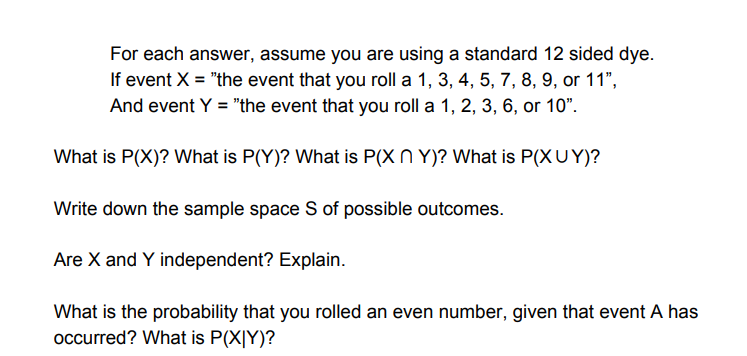Need your help in probability problems? Thanks :)

2 Answers
See below
Explanation:
P(x)=
P(Y)=
P(X nn Y)
P(X uu Y)
The sample space would be the numbers 1 to 12
The events are dependent as 1 and 3 are in both events
Given event A has occurred P(even)=
Sorry don't know what P(X/Y) means
What is #"P"(X)# ?
The probability of event
#"P"(X)="the number of elements in X"/"the number of elements in S"#
Since there are 12 possible rolls,
#"P"(X)=8/12#
#color(white)("P"(X)) = 2/3#
What is #"P"(Y)# ?
Similarly,
#"P"(Y)=5/12#
What is #"P"(X nn Y)# ?
The event
#"P"(XnnY) = 2/12#
#color(white)("P"(XnnY)) = 1/6#
What is #"P"(XuuY)# ?
The event
By observation, we see
#"P"(XuuY) = 11/12#
Write down the sample space #S# of possible outcomes.
#S={1, 2, 3, 4, 5, 6, 7, 8, 9, 10, 11, 12}#
Are #X# and #Y# independent? Explain.
Two events
#"P"(XnnY) = "P"(X) xx "P"(Y)#
From above, we know
#1/6 stackrel"? "= 2/3 xx 5/12=(1xx5)/(3xx6)=5/18 != 1/6#
Since
What is the probability that you rolled an even number, given that event #A# has occurred?
There is no event
#"P"("even"|X)= "the number of even numbers in X"/"the size of X"#
Event
#"P"("even"|X)= 2/8#
#color(white)("P"("even"|X))= 1/4#
What is #"P"(X|Y)# ?
Similarly,
#"P"(X|Y) =("the size of X "nn" Y")/"the size of Y"= ("P"(X nn Y))/("P"(Y))#
#color(white)("P"(X|Y)) = 2/5#


